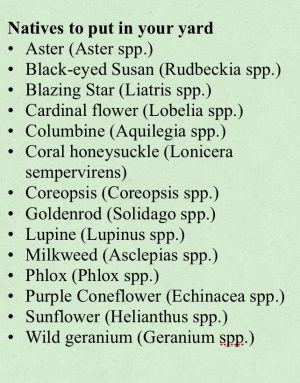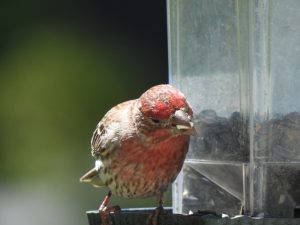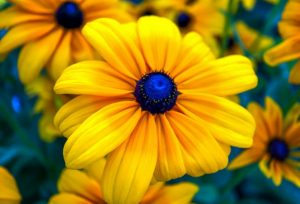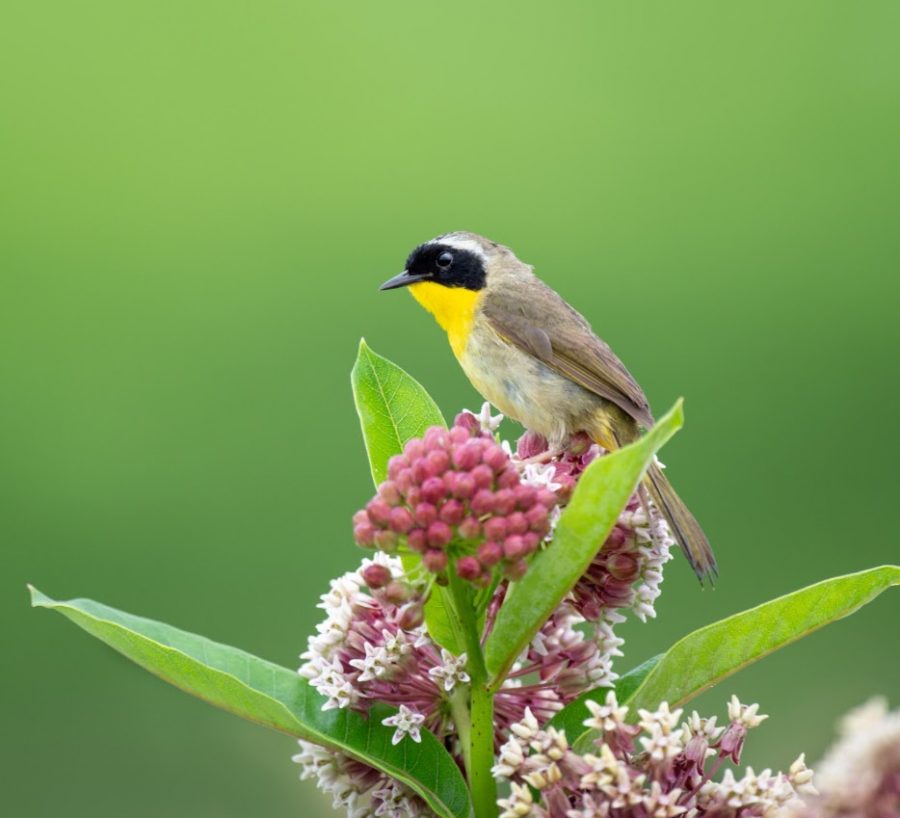How to Incorporate Ecological Restoration into Landscaping
A Common Yellowthroat takes a moment’s rest on a Milkweed plant
The Importance of Biodiversity
As a result of hyper-development, habitat and wildlife populations have been decreasing rapidly. In fact, 30% of North American birds are in decline, and a third of all American wildlife faces a serious threat of extinction.
Though things seem dire, believe it or not: we can still help bring back habitats and the vibrant ecosystems that used to thrive in our area by implementing some easy practices. Homes that plant with the environment in mind can bring back the vegetation that supports wildlife. If thoughtfully planned out, even a simple garden can support twice the diversity of species as that of a regular yard.
Many animals can live in close proximity to human development if just enough of their needed habitat can be found in neighborhoods. Planting various species increases the biodiversity of a yard, and each animal, plant, or insect plays a significant role. The greater the biodiversity, the more an ecosystem will be able to rebound from any significant changes to sustain itself and human life. Even in urban locations, gardening is essential, as wildlife is very adaptable. When space is limited, container gardens, raised beds, and window boxes with native wildflowers are ideal. Some great flowers to plant in containers that increase biodiversity are coreopsis (Coreopsis spp.), lavender (Lantana spp.), marigold (Tagetes spp.), mint (Mentha spp.), phlox (Phlox spp), oregano (Origanum spp.), and sunflower (Helianthus spp.).
If you live in a rural area, there is a lot of space to work with and an even greater diversity of species to behold. A plan for your yard could involve allocating space for a lawn, meadow area, wetland ponds, densely planted trees, brush piles, and other spaces for wildlife to thrive. In suburban areas, rewilding your yard by removing invasive plants and planting more trees and wildflowers to provide food and shelter for wildlife can help restore the natural habitat.
Converting Your Lawn Area into an Ecosystem
In many suburban neighborhoods, the ideal picture of a yard is one only with neatly cut grass and a few pruned ornamental shrubs. However, from a biodiversity standpoint, lawns are sterile areas. By transforming an empty lawn area into a planted landscape, they can have great potential to restore natural ecosystems. Lawns take up nearly 40 million acres of natural habitat in the United States, and they also make up 30% of the total water used in the summer in the eastern United States and 60% in the West. If people planted a quarter or half of their yard with native species, not only would it help restore the vital habitats for animals, it would bring new life and vibrancy to their neighborhoods.
Removing Invasive Species
Non-native plants are those that have been introduced by humans unnaturally to a different ecosystem. Many of these plants can become invasive, spreading aggressively and throwing the natural ecosystem out of balance. They can out-compete native plants that are much better at bolstering the wildlife in the area. Most of these invasive plants have been introduced as ornamental shrubs for their aesthetic value. Next time you choose which plants to grow in your garden or yard, make sure they are not invasive. For example, Japanese barberry (Berberis thunbergii) is a bush that is often sold in nurseries, but it can displace native shrubs and makes the soil more basic through falling leaves. Other common invasives are purple loosestrife (Lythrum salicaria), Chinese wisteria (Wisteria sinensis), English ivy (Hedera helix), bamboo (Phyllostachys spp.), autumn olive (Elaeagnus umbellata), and porcelain berry (Ampelopsis brevipedunculata).
Planting Native Species
Nature is made up of complex interactions and food webs, creating an interdependent ecosystem. Animals depend on the native plants in the area, with which they have formed symbiotic relationships. These plants are also easier to take care of— they are well adapted to the soil, climate, and rainfall in the region. They do not need extra watering or fertilizers and play a crucial role in the dance of the ecosystem.
Native plants also provide excellent sources of food and nectar to attract and restore birds, native bees, and butterflies to your yard. Pollinators, though tiny, transfer the energy from plants to many other species. In doing so, they not only keep the water clean and aid agricultural growth; they benefit the plants that capture carbon, making the earth more habitable for humanity. Pollinators, though, depend on the nectar from the native species and the generosity of humans not to spray pesticides.

Native species also support more bugs and caterpillars, which most bird species rely on exclusively to feed their young. This revitalizes the complex food webs needed to support the birds, reptiles, and mammals that used to thrive in the United States. For example, White Oaks (Quercia alba) support 557 caterpillar species in the Mid-Atlantic United States, allowing many birds and mammals to survive as well. Furthermore, some insects require a specific native plant to feed on, which they have adapted to and depended on over many years of evolution. An example of this is the Monarch butterfly that solely feeds on milkweed (Asclepias spp.). This iconic and stunning butterfly will only continue to flourish if milkweed is restored to yards.
Other Sustainable Practices:
No Fertilizers or Pesticides
Fertilizers, pesticides, and herbicides harm the environment—the toxicity of these chemicals damage many plants and animals. Herbicides often kill important native plants along with weeds. Insecticides also can kill pollinators needed for healthy gardens and insects required for birds’ diets. Pesticides and rodenticides can eliminate small mammals that are key to intricate food webs. Some alternative practices are hand-pulling weeds, pouring boiling water or vinegar on weeds, using compost or cover crops instead of fertilizer, or attracting insects like native ladybugs, mantids, and lacewings that eat pests.
Limiting Cats
Cats are beloved members of many households but are not as welcome in the natural ecosystem. Since domesticated cats are not native to North America, they disrupt the long-standing balance in nature. It is estimated that cats kill up to 4 billion birds and 22 billion mammals each year in the United States. If you have a cat, consider keeping it indoors, where it is safer for the environment and keeps your cat away from dangerous cars and potential disease. To simulate the outdoor experience, you can hide treats and toys around your house, train the cat to walk on a leash or install a catio: a screened-off outdoor space for the cats to play in safely.
Bird Feeders
Sources of food are vital for keeping bird populations healthy. Native plants are the best way to provide food for feathered beauties since they contain nutritious berries and attract caterpillars and other insects necessary to a bird’s diet. However, putting up a bird feeder can be an extra treat and a breathtaking experience. The easiest food to attract various birds are seeds, like black-oil sunflower, striped sunflower, sunflower hearts, safflower, nyjer, red millet, white millet, cracked corn, or peanuts. Birds like hummingbirds and orioles enjoy nectar. Fruit jelly, peanut butter, orange halves, raisins, or grapes are also a welcome treat. Make sure to clean the feeders regularly to prevent disease. Be sure to hang the feeder where you can easily see it so you can enjoy the show.

Bird Baths
All mammals need water to drink. Birds also require water for bathing since it is harder to fly with dirty feathers. Providing a birdbath in your yard, whether it be a muddle puddle or elevated dish, will attract and benefit the wildlife.
Make a Rain Garden
To take advantage of the poorly draining or muddy areas in your yard, you can create a rain garden. The purpose of these gardens is to soak up rainwater, limit erosion, and prevent pollution and fertilizers from entering nearby bodies of water. To do this, find an area that receives a lot of water or one next to a storm drain and dig a hole about 14-18 inches deep. Direct the water source into the hole, fill with sand, soil, or compost, then plant native wetland plants that are adapted to absorb water. Some great species to grow are: cardinal flower (Lobelia cardinalis), black-eyed susan (Rudbeckia fulgida), swamp milkweed (Asclepias incarnata), Swamp mallow (Hibiscus moscheutos), joe pye weed (Eupatorium), sedges (Carex), bluestar (Amsonia), and turtlehead (Chelone).

Bird/Bee Nesting
Another entertaining and rewarding activity for the whole family is to build a bird box or bee nesting house. Since bird populations are dwindling due to habitat loss, bird boxes can help provide a safe space. Of course, shrubs and trees are the best natural nesting places. However, bird nesting boxes are also good spots for birds to raise their young.
So what are some ways that you can build your own bird box?
First, select a specific nest box for a particular species of bird you would like to attract. Then, you can create that box using natural untreated wood. Some useful features you can add to your bird box are ventilation and drainage holes, a sloping roof, and grooves in the front of the inside so baby birds can easily hop out.
One project for a bee nesting box is to cut and hollow out about ten dried plant stems into 6-inch pieces. Then, tie them together and hang them in a place that gets lots of sun. Another option is to place a full toilet paper roll with the hole facing up in the soil near the beginning of spring. This will attract a queen bee that may start a native bee colony. Lastly, you can drill several holes in small blocks of wood. By placing these blocks of wood or ‘bee hotels’ in various spots in your yard, you can help restore the native bee population and make it more difficult for predators to disrupt.
Conserve Water
Water is the resource that all life depends on, so it is vital to protect it. A simple way to conserve water is to plant native plants, as they require much less water than non-native ornamental plants and lawns. Xeriscaping is also effective, which involves using landscaping techniques and plants that hardly require water. If watering is necessary, do it in the morning so that it does not evaporate too quickly. Also, aim directly at the roots instead of the top of the bushy plants. In addition, mulching and collecting rainwater are sustainable ways to conserve water.
You Can Make a Difference
Many people have already begun making their yards more eco-friendly. Landscaping in an environmentally conscious way is highly rewarding, as the wildlife that returns to neighborhoods is a beautiful sight to behold. If enough people are committed to restoring habitat in their yard, it will make a substantial difference for wildlife in our area — and for us.
Sources/Further Reading
Attenborough, David, and Jonnie Hughes. A Life on Our Planet: My Witness Statement and a Vision for the Future. Thorndike Press, 2021.
Mizejewski, David. National Wildlife Federation®: Attracting Birds, Butterflies & Other Wildlife to Your Backyard. Creative Homeowner, 2019.
Swearingen, Jil, et al. Plant Invaders of Mid-Atlantic Natural Areas. National Park Service, 2014.
Tallamy, Douglas W. Natures Best Hope: a New Approach to Conservation That Starts in Your Yard. Timber Press, 2020.


